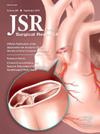Assessment of Amniotic Fluid as a Preservation Solution in Pig Livers Undergoing Machine Perfusion
IF 1.8
3区 医学
Q2 SURGERY
引用次数: 0
Abstract
Introduction
Ischemia-reperfusion injury in organ transplantation highlights the need for advanced preservation techniques. This study evaluates the effectiveness of amniotic fluid (AF) compared to static cold storage and histidine-tryptophan-ketoglutarate (HTK) solution in preserving pig livers subjected to hypothermic oxygenated machine perfusion (HOMP) and ex vivo normothermic reperfusion.
Materials and Methods
Fifteen pig livers underwent warm ischemia for 1 h, followed by preservation under three conditions: cold storage (group 1, n = 3), HOMP with HTK (group 2, n = 3), and HOMP with AF (group 3, n = 3). Perfusion lasted 4 h, followed by 2 h of ex vivo reperfusion. Assessments included hepatic bile production, sphingomyelin levels, reactive oxygen/nitrogen species, antioxidant capacity, tissue oxygen saturation, flow dynamics, blood gas analyses, biochemical markers, and histopathological and immunohistochemical evaluations.
Results
AF-HOMP showed superior blood flow, lower vascular resistance, higher oxygen saturation, and better organ protection than HTK. Blood gas measurements demonstrated stable physiological levels after reperfusion. AF-HOMP improved bile production, sphingomyelin levels, glycogen preservation, and reduced parenchymal necrosis, hepatocyte vacuolization, and sinusoidal obstruction. Immunohistochemical analysis indicated protective effects on bile duct function, apoptosis, endothelial activation, and cell proliferation.
Conclusions
AF-HOMP outperformed HTK in preserving liver tissue during warm ischemia, HOMP, and reperfusion. AF is a promising, cost-effective, and accessible alternative for liver preservation, potentially expanding donor pools and improving transplantation outcomes. Further research is warranted to explore its broader applications.
求助全文
约1分钟内获得全文
求助全文
来源期刊
CiteScore
3.90
自引率
4.50%
发文量
627
审稿时长
138 days
期刊介绍:
The Journal of Surgical Research: Clinical and Laboratory Investigation publishes original articles concerned with clinical and laboratory investigations relevant to surgical practice and teaching. The journal emphasizes reports of clinical investigations or fundamental research bearing directly on surgical management that will be of general interest to a broad range of surgeons and surgical researchers. The articles presented need not have been the products of surgeons or of surgical laboratories.
The Journal of Surgical Research also features review articles and special articles relating to educational, research, or social issues of interest to the academic surgical community.

 求助内容:
求助内容: 应助结果提醒方式:
应助结果提醒方式:


